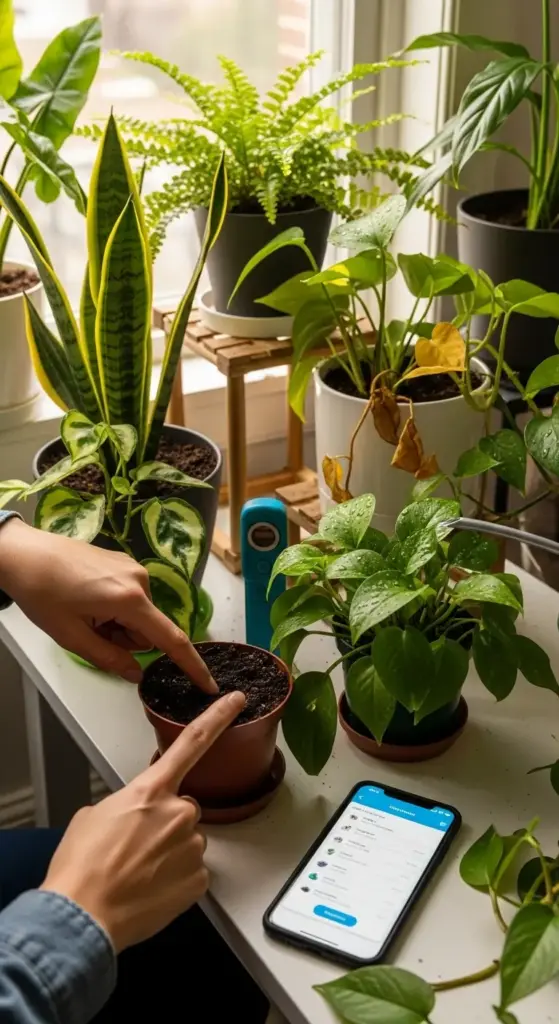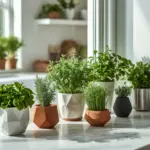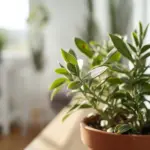3. Nail Your Watering Schedule (The #1 Plant Killer)

I’m not even kidding when I say watering killed more of my plants than pests, diseases, and bad lighting combined. For the longest time, I thought I was being a good plant parent by watering every single day.
Turns out, I was basically drowning my green babies with kindness.
Understanding Your Plant’s Specific Water Needs
Here’s what nobody tells you: every plant drinks differently. It’s like having houseguests with completely different dietary needs.
My snake plant can go weeks without water, while my Boston fern acts like it’s dying of thirst every few days. Learning this difference was my biggest breakthrough.
Succulents want deep, infrequent watering. I used to sprinkle them daily like they were lawn grass. No wonder they kept rotting on me!
Tropical plants from humid environments need consistent moisture but not soggy soil. Think of it like a wrung-out sponge – damp but not dripping.
Desert plants prefer the feast-or-famine approach. Soak them thoroughly, then let them dry out completely before the next drink.
Creating a Foolproof Watering Calendar
I tried keeping a watering schedule in my head for months. Spoiler alert: my brain is not a reliable plant calendar.
The finger test changed everything for me. Stick your finger 1-2 inches into the soil. Dry? Time to water. Still moist? Wait another day or two.
Different plants, different schedules. My pothos gets watered weekly, my ZZ plant monthly, and my fiddle leaf fig every 10 days or so.
I started using my phone’s reminder app with specific plant names. “Water Philodendron Phil” pops up every Tuesday, and “Check Snake Plant Sally” appears every other Sunday.
Seasonal changes mess with schedules big time. What worked in summer definitely won’t work in winter when growth slows down.
Signs of Overwatering vs. Underwatering
This one took me forever to figure out because both problems can make leaves turn yellow! Talk about confusing.
Overwatering signs: Mushy stems, black roots, fungus gnats flying around, and that gross swamp smell. Been there, done that, lost the plant.
The soil stays wet for days and days. If you’re still seeing moisture a week after watering, you’ve got drainage issues.
Underwatering signs: Crispy leaf edges, wilting that doesn’t bounce back after watering, and soil that’s pulling away from the pot sides.
Underwatered plants perk up pretty quickly once you give them a drink. Overwatered plants? Not so much.
I killed a beautiful peace lily by overwatering, thinking its droopy leaves meant it was thirsty. Turns out it was drowning!
Seasonal Watering Adjustments
Winter was my plant graveyard until I figured this out. Plants basically hibernate in colder months with less light.
Summer watering might be twice a week, but winter could be once every two weeks for the same plant. The growth slows way down.
Heating systems dry out the air like crazy. I had to water more frequently once the heat kicked on, but less volume each time.
Spring is tricky because plants wake up and start growing again. I gradually increase watering frequency as days get longer.
Air conditioning in summer can also affect watering needs. My apartment gets super dry when the AC runs constantly.
Water Quality Considerations for Urban Environments
Tap water in most cities is fine for plants, but some are pickier than others. My spider plants developed brown leaf tips until I started using filtered water.
Chlorinated water can be harsh on sensitive plants. I fill watering cans and let them sit overnight so the chlorine evaporates.
Hard water leaves mineral deposits on leaves and can build up in soil over time. I learned this when my plants started getting crusty white residue.
Distilled water is great for finicky plants like calatheas, but it gets expensive fast if you have a lot of plants.
Rainwater collection is free and plants love it! I keep a bucket on my balcony during storms.
Smart Watering Tools and Apps for Busy Lifestyles
Technology finally caught up with my plant obsession! Moisture meters take the guesswork out of when to water.
I bought a $10 moisture meter from Amazon and it’s been a game-changer. No more guessing if the soil is actually dry down deep.
Plant care apps like PictureThis and PlantNet help identify watering needs for specific plants. Some even send push notifications!
Self-watering pots saved my plants during a two-week vacation. They’re not perfect for every plant, but they work great for consistent moisture lovers.
Watering globes look pretty and provide slow, steady water release. Perfect for when you’re away for a few days.
I tried those plant monitoring sensors that connect to your phone. Honestly? A bit overkill for most people, but the data nerd in me loved seeing soil moisture graphs.
Ready to give your properly watered plants the light they need to thrive? The next section covers optimizing light conditions – including my expensive mistakes with grow lights and the simple tricks that actually work. Click “next” to discover how to turn any space into a plant paradise!









GIPHY App Key not set. Please check settings